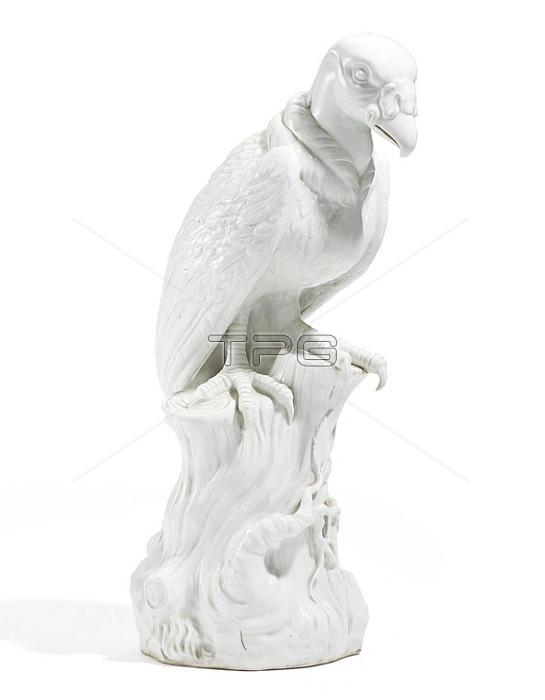
LARGE PORCELAIN FIGURINE OF A STANDING KING VULTURE
Meissen. 1924-34. Model J.J. Kaendler
Porcelain; white. A large king vulture; standing on a tree trunk. Its measurements fit to two entries in the inventories of the Japanese Palais from 1770 and 1790. There it says: "Krob Vogel bunt gemalt auf hohen Postament mit Laubwerck belegt; schadhafft; 1 Elle 6 Zoll hoch" ("King vulture painted colourfully on high pedestal with foliage; damaged; 1 cubit 6 inches high"). Height 73cm.
Pfeiffer mark; 122; porcelain former's no. 37; 141. Condition A.
Provenance:
Hessian private collection.
Literature:
- Pietsch; Ulrich: Mei遪er Porzellanplastik von Gottlieb Kirchner und Johann Joachim
Kaendler; Munich 2006; for the vulture cf. p. 135; cat. no. 194.
- Eikelmann; Renate (ed.): Mei遝ner Porzellan des 18. Jahrhunderts - Die Stiftung Ernst
Schneider in Schlo?Lustheim; Munich 2004; p. 374.
- Sponsel; Jean Louis: Kabinettst點ke der Meissner Porzellanmanufaktur von Johann Joachim
K鋘dler; Leipzig 1900; p. 6; 8; 14; 65; 82; 89.
- Schnorr von Carolsfeld; Ludwig: Porzellan der europ鋓schen Fabriken des 18.
Jahrhunderts; Berlin 1912; p. 53.
Dresden in the 18th century owed its Europe-wide fame as a centre of courtly splendour to
the elector Frederick Augustus I (1670-1733). 'August the Strong' had a distinct passion
for collecting and was not only a patron and lover of the arts; but also an enthusiastic
patron of science. His natural history cabinet was regarded as the most important
collection of its kind in Europe and contained a large number of exotic animals. He
financed expeditions; from which the researchers were to bring the 'most possible species
of their animals alive or in skins and skeletons or even crushed' back to Dresden. Johann
Joachim Kaendler had this extensive collection of partly living exhibits at his disposal
when he was commissioned to design life-sized animal sculptures for the 'Japanese Palace'.
Built in 1715 by Matthias Daniel P鰌pelmann for Count Flemming; the palace was acquired by
the elector in 1717 because the number of his collections and the scale of courtly
festivities required more space. The decision to house the rapidly growing collection of
Asian porcelains in the Palais was made two years later. Soon the possibility of
exhibiting products from the increasingly successful Meissen manufactory there was also
considered. A plan that soon took on proportions that required an extension of the
facility; given the electors's love for pomp and circumstance. In addition to
accommodating the existing collection; the plan also included the production of new;
special cabinet pieces - to an extent that made it necessary to hire another modeller in
addition to Johann Gottlieb Kirchner. In 1731; August the Strong chose Johann Joachim
Kaendler; who quickly succeeded in demonstrating his extraordinary talent with porcelain
as a material.
The German writer Johann Georg Keypler (1693-1743) describes in a travelogue from the year
1740 the plans for the new Japanese Palace. There it reads: 'The rooms on the top floor
[...] are filled with nothing but Meissen porcelain [...]. Such is furnished with all
sorts of native as well as foreign birds and animals of pure porcelain; in their natural
size and colours; and of those pieces that are already finished one cannot admire the art
and beauty enough.'
The extraordinary quality of the animal sculptures is remarkable; especially since they
were Kaendler's first works for the manufactory. His particular talent lay in capturing a
characteristic moment in the movement of the animal and reproducing it naturalistically;
which gives the sculptures an extraordinary liveliness.Art trade; Van Ham.
| px | px | dpi | = | cm | x | cm | = | MB |
Details
Creative#:
TOP28416639
Source:
達志影像
Authorization Type:
RM
Release Information:
須由TPG 完整授權
Model Release:
No
Property Release:
No
Right to Privacy:
No
Same folder images:

 Loading
Loading